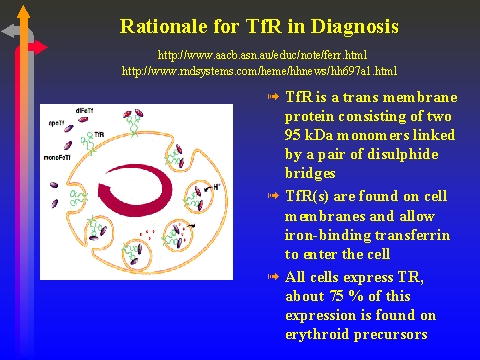Slide 8 of 43
Notes:
Recently a new protein called transferrin receptor (TR) has been found to correlate with iron deficiency. TR is a trans membrane protein consisting of two 95 kDa monomers linked by a pair of disulphide bridges. Each TR dimer can bind two transferrin molecules for transport into the cell by endocytosis. Although all cells express TR, about 75 % of this expression is found on erythroid precursors.
Soluble TR, consistently found in serum as a 85 kDa monomer, is associated with a 3-5 fold increase with iron deficiency with no overlap with normal subjects. As the storage compartment becomes depleted ferritin usually plateaus out at 12 ug/L. In contrast as the functional compartment becomes progressively depleted, serurn TR concentrations continue to rise inversely to the extent of the iron deficit. Most of this increase appears to be due to increased receptor expression although part of the increase may result from ineffective erythropoiesis. As the functional compartment is depleted anaemia results due to depressed haemoglobin synthesis. Serum TR is the only marker to accurately plot the progress from storage to functional compartment deficiency or anaemia. Unlike ferritin, serum TR is able to accurately predict iron deficiency where there is an anaemia of chronic disease. Indeed in this clinical setting TR concentrations give a positive predictive value for iron deficiency of 91 % and a negative predictive value of 95 %. It is also useful in pregnancy and is only raised when functional iron depletion















